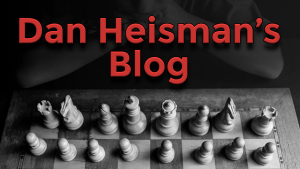Q&A with Coach Heisman Dec 7, 2012
Mongoose Press graciously offered free copies of The World's Most Instructive Amateur Game Book for the best question on each of the Dec 7 and Dec 21 shows. I scribbled down seven questions which were contenders for the prize. Here they are (I apologize if I scribbled a handle incorrectly or the short paraphrase of the questions are not super-accurate) with summaries of my answers:
(Winning Question by Game_of_Chess) "What do you think of the extension to PGN and other portable notations to supply time stamping information? What book or material led you to believe that it was valuable?"
Answer summary: This is notation that looks something like "1. d4 {0:02:05} d5 {0:02:05} 2. c4 {0:02:17} dxc4 {0:02:17} " with the time remaining in braces. Since chess is a thinking game and time management and thought process are cousins, this is vital information. A mistake made in 10 seconds may be indicative of a completely different problem than the identical mistake made in 10 minutes. I don't know the standards committees that work with this (perhaps thru FIDE?), but time-stamping is very helpful for an instructor. Chess.com is working on providing that information when replaying a game on their "live" server. As for origin, the book Tal-Botvinnik 1960 was my first book that included time-stamping, and I was hooked once I realized how much insight that information provided.
Honorable Mentions:
(Question by JWhitesJ): "How does one know when to conduct an attack by pawns vs one by pieces?"
Answer summary: They write books about this (How about The Art of Attack by Vukovic as a classic)! However, we can make a generality: the more open the position, the more the pieces can attack independently of pawn support. The more closed the position, the more the pieces are more effective behind pawns, which are often used as battering rams. Consider the closed position resulting from one of the Main Lines of the King's Indian Defense:
(SCSIDuck): "In turn-based games on Chess.com one is allowed to use opening information and databases. How is this best used to help your game?"
Answer summary: Turn Base (Correspondence with three day moves) is a great way to learn openings and do careful analysis. See the Chess.com Game Explorer - take a few minutes to play around with it and learn to use it. Correspondence isn't so great for visualization since you are allowed (and thus may as well) to move the pieces when analyzing.
(bcas1984): "What was the creation of the Elo rating system and how does a similar rating vary when the population pools are different?"
Answer summary: Arpad Elo created the rating system around 1950 for the US Chess Federation (USCF) and wrote a book about it which I purchased in the 60's, The Rating of Chess Players, Past and Present. Once you have played about 25 games with players near your level the rating is pretty accurate. These days the Elo system is used for more than just chess, such as betting on football games! In 2000 Dr. Mark Glickman, head of the USCF Rating Committee, helped the USCF go to a more advanced version, closer to his "Glicko-2" refinement of Elo. As for pools, if you had two rooms of players who were all unrated, but one room had all 7 year old beginners and the other room had all grandmasters, if each room only played each other then the average in each room would stay at 1500 because the best player in the 7 year old room, say rated 2200 there based on play with just his peers, is the best of the beginners. Meanwhile the worst grandmaster in the other room might be rated 1000 or so even though he could be the 2200 player in the 7 year old room blindfolded with queen odds  . So the strength of the pool being rated matters a lot. What is 1500 on one server might not be 1500 in a USCF rated event. Aside: In USCF terminology an "unrated" event is an one that may or may not be rated, but designed for players who are currently not rated, e.g. The Unrated section of the World Open is a rated section for those currently unrated!. A "non-rated" event is one that will not be rated. Nevertheless, very few players use the term "non-rated" - they use "unrated" to mean both a player without a rating (correct) and an event/game that won't be rated (not accurate re USCF, but may be the correct terminology somewhere else, like an online server).
. So the strength of the pool being rated matters a lot. What is 1500 on one server might not be 1500 in a USCF rated event. Aside: In USCF terminology an "unrated" event is an one that may or may not be rated, but designed for players who are currently not rated, e.g. The Unrated section of the World Open is a rated section for those currently unrated!. A "non-rated" event is one that will not be rated. Nevertheless, very few players use the term "non-rated" - they use "unrated" to mean both a player without a rating (correct) and an event/game that won't be rated (not accurate re USCF, but may be the correct terminology somewhere else, like an online server).
(AJ): "How does a player recognize and correct his bad habits?"
Answer summary: Here's where computers and books can only help so much - they can't see what you are doing! You don't need an instructor (In Defense of Chess Instruction), but you do need a big brother, friend, club buddy, or someone strong who can help recognize things you can't recognize for yourself. Some players can get fairly strong without much outside help, but everyone at some point can at least use pointers from the better players, especially with regards to objective evaluation. I never had a formal coach but I was extremely grateful to have so many who were informal, such as Bob Schumsky, Jerry Kolker, Rich Pariseau, Don Latzel, Rich Lunenfeld, and Donald Byrne. By the way, sometimes correcting bad habits takes the form of 1)Awareness of the habit, 2)Understanding how to fix it, 3)Willingness to fix it, and 4)Will power and concentration to consistently apply a fix
(RedBaron54): "How do you best analyze your own games?"
Answer summary: In written form, Reviewing Chess Games is a good start. The Introduction to my book The Improving Chess Annotator is about annotating games, but that is more than just analyzing. The first step is to go to post-mortem and pick your opponent's brain, e.g. "What would have done if I had played this?" "Do you know this opening better than I - what was the main idea?" and, most importantly, "What was the losing move?" Then you can analyze a little yourself, using an opening book or database, trying to find the truth, i.e. "If I had to play this game again and my opponent played identically, where would I differ?" and how good your analysis was now that you have time to think, and even move the pieces if necessary. Next, you can give the game to a computer to isolate any tactical mistakes (omission: you missed a win or draw; commission: you made a mistake allowing your opponent to win or draw). Finally, you can go over the game with a strong player to find out what he thinks of your play (don't forget the time-stamping! 
(ImOnlySleeping): "When should one play a rook's pawn up two moves instead of one?"
Answer summary: If you are looking for luft (air for your king) then, if moving up two provides attacking chances with that pawn as well as the defensive purpose, two's the way to go. If you are not looking for luft for your king, then it's more complicated. Moving up two instead of one may be to go for a break move against your opponent's knight pawns, or to dislocate a piece located on the knight's files. Often there are tradeoffs between moving a pawn one or two (the former may be safer but the latter more aggressive and yields more space) but one thing is certain: often intermediate players make a late-middlegame "standard" move like h3 when it is clear that h4 would give them better chances. For a player who was really good at moving his rook pawns up two spaces, check out the excellent book Bent Larsen's Best Games of Chess.






